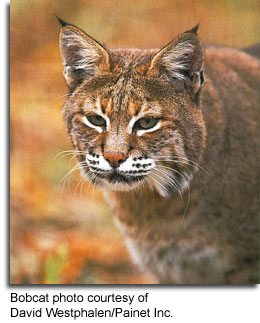Bobcat
(Lynx rufus)
 Description:
Description:
Bobcats are medium-sized wild cats with a distinct “bobbed” tail. They have
wide faces with tufts of black fur on their ears in addition to spotted
stomachs. Bobcat fur is a tawny color and contains patterns of stripes and
spots.
Range:
In the late 1800s, the dramatic destruction of forests in much of Maryland
reduced the bobcat population to extremely low levels. As forests have
regenerated, bobcat numbers have increased. Bobcats are mainly found in western
Maryland, but they can also occasionally be seen in the Piedmont and very rarely
on the Coastal Plain. Bobcats are considered to be uncommon in Maryland.
Habitat:
Bobcats live solitary lives in mixed deciduous-conifer forests and hardwood
forests. Bobcats also tend to prefer brushy and rocky woodlands broken by
fields, old roads and farmland. Rocky ledges are used many times for courtship
and den sites.
Diet & Behavior:
Bobcats are usually active from dusk until dawn. Bobcats are very patient and
stalk their prey. Their main prey items include cottontail rabbits, woodchucks,
squirrels, chipmunks, mice, voles, snowshoe hares and birds. Occasionally,
bobcats will eat old, sick or young deer. Bobcats tend to be opportunists and
will feed on most small mammals.
Reproduction:
Bobcats breed between January and May. After a gestation period of 60-62
days, two to three kittens will be born. The kittens will stay with the female
for a year. Females will have several dens within her territory, with one main
den and several auxiliary dens to use for temporary shelter. Male bobcats do not
help raise the young.
Did You Know?
Bobcats can jump up to 10 feet! Bobcats sometimes cache their food by
covering it with leaves, snow or sticks to eat it at a later time. While bobcats
have great vision, they have a very poor sense of smell.
Click here to learn more information about wildlife management of the species.
Bobcat photos courtesy of David Westphalen/Painet Inc.